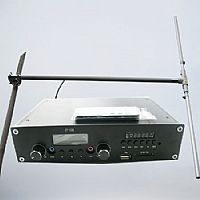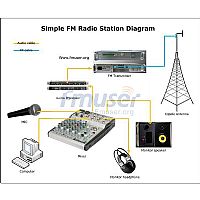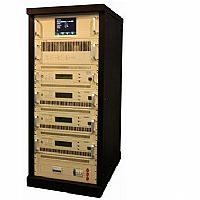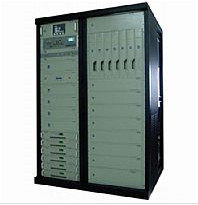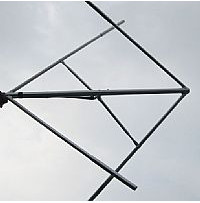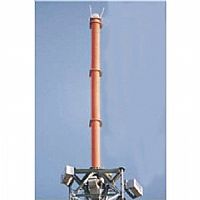|
Low Power Broadcast Radio Stations
The Commission receives tens of thousands of inquiries annually from individuals and groups wishing to start a "low power" or "micro power" radio station for local broadcasts (AM or FM). The Audio Division has assembled this general information to answer some of the more commonly received questions on this subject.
You may click on any of the topic headings in the Table of Contents to jump directly to a particular section, or you may scroll through the topics which start sequentially after the Table of Contents.
TABLE OF CONTENTS
Related information about broadcast stations is located at:
UNLICENSED OPERATION
The next four sections cover the permitted forms of unlicensed operation in the AM band (535 to 1705 kHz) and FM band (88 to 108 MHz), and explain the penalties which may be assessed against those forms of unlicensed operation which do not fall within the permitted forms of unlicensed operation.
PART 15 DEVICES
Unlicensed operation on the AM and FM radio broadcast bands is permitted for some extremely low powered devices covered under Part 15 of the FCC's rules. On FM frequencies, these devices are limited to an effective service range of approximately 200 feet (61 meters). See 47 CFR (Code of Federal Regulations) Section 15.239, and the July 24, 1991 Public Notice. On the AM broadcast band, these devices are limited to an effective service range of approximately 200 feet (61 meters). See 47 CFR Sections 15.207, 15.209, 15.219, and 15.221. These devices must accept any interference caused by any other operation, which may further limit the effective service range. For more information on Part 15 devices, please see OET Bulletin No. 63 ("Understanding the FCC Regulations for Low-Power, Non-Licensed Transmitters"). Questions not answered by this Bulletin can be directed to the FCC's Office of Engineering and Technology, Customer Service Branch, at the Columbia, Maryland office, phone (301) - 362 - 3000, OET Laboratory Division help page.
Return to Table of Contents
CARRIER CURRENT or CAMPUS RADIO STATIONS
Carrier Current Stations, also referred to as Campus Radio Stations, do not require a license to set up and operate. In general, a carrier current station consists of an AM radiofrequency signal on a frequency between 535 and 1705 kHz being injected into a power line. The effective service range of a carrier current station is approximately 200 feet (61 meters) from the power line; however, a carrier current signal will not pass through a utility transformer. These stations are governed by 47 CFR Sections 15.207(c), 15.209(a), and 15.221 of the Commission's rules. For more information on Carrier Current Stations, please see OET Bulletin No. 63 ("Understanding the FCC Regulations for Low-Power, Non-Licensed Transmitters"). Questions not answered by this Bulletin can be directed to the FCC's Office of Engineering and Technology, Customer Service Branch, at the Columbia, Maryland office, phone (301) - 362 - 3000, OET Laboratory Division help page.
Return to Table of Contents
PROHIBITED FORMS OF LOW POWER OPERATION
A license or a construction permit is required for forms of operation in the AM and FM radio broadcast bands which cannot be classified as Part 15 or Carrier Current Stations . This license or construction permit must be obtained from the Commission prior to construction of a broadcast station and before operations may commence. For more information on application filing requirements for licensed operation, see our Information Sheet about How to Apply For A Broadcast Station.
Return to Table of Contents
PENALTIES FOR OPERATION WITHOUT A PERMIT OR LICENSE
The Commission considers unauthorized broadcast operation to be a serious matter. Presently, the maximum penalty for operating an unlicensed or "pirate" broadcast station (one which is not permitted under Part 15 or is not a Carrier Current Station) is set at $10,000 for a single violation or a single day of operation, up to a total maximum amount of $75,000. Adjustments may be made upwards or downwards depending on the circumstances involved. Equipment used for an unauthorized operation may also be confiscated. There are also criminal penalties (fine and/or imprisonment) for "willfully and knowingly" operating a radio station without a license. DON'T DO IT!
Sample Enforcement Bureau orders for unlicensed operations
Return to Table of Contents
In the following sections, we describe the rules governing operation of a lawful broadcast station. If the station being applied for does not propose to operate in conformity with the FCC's rules, the appropriate construction permit or license application sent to the Commission must be accompanied by a request for waiver of the relevant rules. The waiver request will be evaluated by the staff and the applicant notified of the Commission's decision.
LOW POWER FM (LPFM) SERVICE (License Required)
In January 2000 FCC created a low power FM radio service. These stations are available to noncommercial educational entities and public safety /travellers information entities, but not individuals or commercial operations. A construction permit or license is required before construction or operation of an LPFM station can begin.
Information on LPFM has been posted on the Audio Division's LPFM page at http://www.fcc.gov/mb/audio/lpfm/index.html, and that material is updated as required.
Return to Table of Contents
MINIMUM POWER LEVELS for LICENSED BROADCAST OPERATION
The minimum power for a standard FM broadcast station which a construction permit applicant may request is 100 watts (0.100 kilowatts). Alternatively, if an effective radiated power of less than 100 watts is sought, the combination of the proposed effective radiated power and antenna height above average terrain must cause the distance to the predicted 1 millivolt per meter (mV/m) contour (or 60 dBu contour) to be greater than 6 km. See 47 C.F.R. Section 73.211 of the Commission's Rules. Please note that new FM stations will not be authorized to operate with less than these minimums. While there are a few Class D FM noncommercial educational stations (also called "10 watt stations") which are permitted to continue operations with smaller facilities, authorizations for new Class D FM stations were discontinued in 1978. No new Class D FM stations will be authorized outside the state of Alaska. See our Information Sheet about How To Apply For A Broadcast Station for additional information on application preparation.
Stations authorized in the new LPFM service will operate with effective radiated powers (ERP) between 1 watt (0.001 kW) and 100 watts (0.100 kW). In any case, the distance to the 1 mV/m (60 dBu) contour from an LPFM station or application will not be permitted to exceed a reference distance of 5.6 km. LPFM applications which would require operation with less than 1 watt ERP will not be accepted for filing.
The minimum power for an AM broadcast station which a construction permit applicant may request is 250 watts (0.250 kilowatts). Alternatively, if an effective radiated power of less than 250 watts is sought, an equivalent RMS value of at least 141 millivolts per meter (mV/m) at a distance of 1 km from the tower site must be proposed. See 47 CFR Section 73.21(a)(2) of the Commission's Rules. No AM broadcast station will be authorized with less than these minimums. See our Information Sheet about How To Apply For A Broadcast Station for additional information on application preparation.
Return to Table of Contents
TRAVELERS' INFORMATION STATIONS
Governmental entities, as well as park districts and authorities, may be eligible to operate a low power AM radio station for the purpose of disseminating information to travellers. A license is required before construction or operation of a Travelers' Information Station may commence. This service, which began in 1977 ( see the June 20, 1997 Report and Order ), is covered under rule Section 90.242 of the FCC's rules. Travelers' Information Stations on the AM band are limited to a 10 watt transmitter output power and the antenna height may not exceed 15 meters (49.2 feet). These stations may not transmit commercial information. This service is not available to individuals or groups, but only to governmental entities and park districts. See 47 CFR 90.242 and 47 CFR 90.20(a). Application for an AM band Travelers' Information Station license may be made on FCC Form 601. The service is administered by the Public Safety and Homeland Security Bureau. For additional information on Travelers' Information Stations, please contact our Gettysburg, PA office at 1 - (888) - 225 - 5322, or by e-mail at [email protected].
Travelers' Information Stations may now be authorized in the new LPFM service created by the Commission on January 20, 2000 (see the LPFM page). FM Travelers' Information Stations will use the same form and be subject to the same procedures applicable to all LPFM applicants. LPFM stations, including FM TIS stations, will be processed by the Audio Division, Media Bureau.
Return to Table of Contents
FREE SPEECH vs. RIGHT TO BROADCAST
A number of inquiries received at the Commission are from persons or groups who believe that there is a First Amendment, constitutionally protected right to broadcast. However, the Supreme Court of the United States has repeatedly ruled on this subject and concluded that no right to broadcast exists.
In National Broadcasting Co. v. United States, 319 U.S. 190 (1943), the Supreme Court stated, in pertinent part, as follows (footnotes omitted):
We come, finally, to an appeal to the First Amendment. The Regulations, even if valid in all other respects, must fall because they abridge, say the appellants, their right of free speech. If that be so, it would follow that every person whose application for a license to operate a station is denied by the Commission is thereby denied his constitutional right of free speech. Freedom of utterance is abridged to many who wish to use the limited facilities of radio. Unlike other modes of expression, radio inherently is not available to all. That is its unique characteristic, and that is why, unlike other modes of expression, it is subject to government regulation. Because it cannot be used by all, some who wish to use it must be denied. . . . The right of free speech does not include, however, the right to use the facilities of radio without license. The licensing system established by Congress in the Communications Act was a proper exercise of its power over commerce. The standard it provided for licensing of stations was the 'public interest, convenience, and necessity.' Denial of a station license on that ground, if valid under the Act, is not a denial of free speech.
In addition, in Red Lion Broadcasting Co., Inc. v. United States, 395 U.S. 367, 89 S.CT. 1794 (1969), the Supreme Court of the United States stated, in pertinent part, as follows (footnotes omitted):
When two people converse face to face, both should not speak at once if either is to be clearly understood. But the range of the human voice is so limited that there could be meaningful communications if half the people in the United States were talking and the other half listening. Just as clearly, half the people might publish and the other half read. But the reach of radio signals is incomparably greater than the range of the human voice and the problem of interference is a massive reality. The lack of know-how and equipment may keep many from the air, but only a tiny fraction of those with resources and intelligence can hope to communicate by radio at the same time if intelligible communication is to be had, even if the entire radio spectrum is used in the present state of commercially acceptable technology.
It was this fact, and the chaos which resulted from permitting anyone to use any frequency at whatever power level he wished, which made necessary the enactment of the Radio Act of 1927 and the Communications Act of 1934. National Broadcasting Co. v. United States, 319 U.S. 190, 210 - 214 (1943). It was this reality which at the very least necessitated first the division of the radio spectrum into portions reserved respectively for public broadcasting and for other important radio uses such as amateur operation, aircraft, police, defense, and navigation; and then the subdivision of each portion, and assignment of specific frequencies to individual users or groups of users. Beyond this, however, because the frequencies reserved for public broadcasting were limited in number, it was essential for the Government to tell some applicants that they could not broadcast at all because there was room for only a few.
Where there are substantially more individuals who want to broadcast than there are frequencies to allocate, it is idle to posit an unabridgeable First Amendment right to broadcast comparable to the right of every individual to speak, write, or publish. If 100 persons want to broadcast but there are only 10 frequencies to allocate, all of them may have the same 'right' to be a licensee; but if there is to be any effective communication by radio, only a few can be licensed and the rest must be barred from the airwaves. It would be strange if the First Amendment, aimed at protecting and furthering communications, prevented the Government from making radio communication possible by requiring licensees to broadcast and by limiting the number of licensees so as not to overcrowd the spectrum.
This has been the consistent view of the Court. Congress unquestionably has the power to grant and deny licenses and to eliminate existing stations. [citation omitted here]. No one has a first amendment right to a license or to monopolize a radio frequency; to deny a station license because 'the public interest' requires it 'is not a denial of free speech.' National Broadcasting Co. v. United States, 319 U.S. 190, 227 (1943).
Return to Table of Contents
"QUIET SPOTS" BETWEEN STATIONS ON THE DIAL
The fact that there are locations on a radio tuning dial which do not receive a broadcast station does not necessarily indicate that a station can be added on that frequency. A station's signal on the same frequency or an adjacent frequency which is too distant or weak to be picked up by a radio receiver can still cause interference to other broadcast stations. For this reason, the Commission's rules require that stations located very close in frequency be located in different communities separated by some physical distance, so as to limit any potential interference.
Before it can be determined whether any "quiet spot" could support a broadcast station, the interested individual or group would need to have an engineering study performed to determine whether the frequency can actually be used. See our Information Sheet about How To Apply For A Broadcast Station.
Return to Table of Contents
. This page is located at http://www.fcc.gov/mb/audio/lowpwr.html.
|

Our other product:

